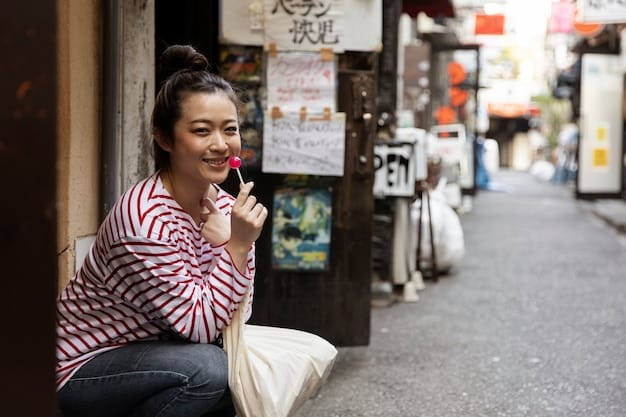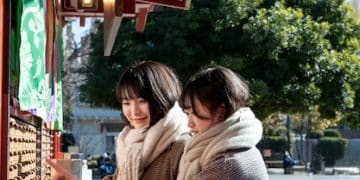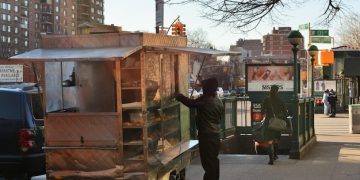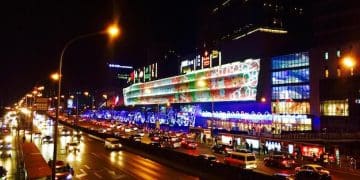Mastering Basic Korean: A US Traveler’s 2025 Survival Guide

Mastering basic Korean phrases is essential for US travelers planning trips to South Korea in 2025, enhancing their cultural experiences and ensuring smooth communication in various situations.
Planning a trip to South Korea in 2025? Mastering some basic Korean phrases is a must to enhance your travel experience. This guide provides essential Korean phrases for US travelers to navigate daily situations with ease and confidence, ensuring a more immersive cultural adventure. Learning even a few phrases can open doors and create memorable interactions.
Why Learn Basic Korean Phrases for Your 2025 Trip?
Traveling to a new country is always exciting, but it can also be daunting if you don’t speak the local language. South Korea, with its rich culture and vibrant cities, offers an unforgettable experience, but knowing some basic Korean phrases can significantly enhance your journey. Let’s explore why learning these phrases is so important.
Enhanced Cultural Immersion
Speaking even a few phrases in Korean shows respect for the local culture and makes you more approachable to locals. It allows you to connect on a deeper level, moving beyond superficial tourist interactions. This can lead to richer, more authentic experiences.
Smooth Communication
While many Koreans in tourist areas may speak some English, relying solely on English can be limiting. Knowing basic Korean phrases allows you to communicate effectively in various situations, from ordering food at local restaurants to asking for directions.
- Respect and Appreciation: Demonstrates your effort to understand the local culture.
- Better Interactions: Facilitates smoother conversations with locals.
- Independent Navigation: Enables you to travel more confidently and independently.
By making an effort to learn the language, you’ll find that locals are often more willing to help and share their culture with you. This creates a more welcoming and enriching travel experience. Remember, a little effort goes a long way in fostering positive interactions.
Essential Greetings and Introductions
Mastering basic greetings and introductions is the foundation of any language. These phrases are your first point of contact and help you make a positive impression. In Korean culture, politeness and respect are highly valued, so starting with the right phrases is crucial. Let’s dive into some essential greetings and introductions.

Basic Greetings
Starting with the proper greetings can set a positive tone for any interaction. Here are some essential greetings you should know:
- 안녕하세요 (Annyeonghaseyo): This is the most common way to say “Hello” in Korean. It’s a polite and formal greeting suitable for most situations.
- 안녕 (Annyeong): This is an informal way to say “Hi” or “Hello,” typically used with close friends and family.
- 좋은 아침이에요 (Joeun achimieyo): This means “Good morning.” You can use it in the morning to greet people politely.
Introductions
Introducing yourself is essential when meeting someone new. These phrases will help you make a good first impression:
When introducing yourself, it’s important to be polite and sincere. Koreans often appreciate the effort foreigners make to learn their language. Remember to maintain a respectful tone and body language. A simple bow can also enhance your introduction.
- 제 이름은 [Your Name]입니다 (Je ireumeun [Your Name] imnida): This means “My name is [Your Name].” It’s a formal way to introduce yourself.
- 만나서 반갑습니다 (Mannaseo bangapseumnida): This means “Nice to meet you.” It’s a polite phrase to use after introducing yourself.
- 저는 [Your Nationality]에서 왔어요 (Jeoneun [Your Nationality] eseo wasseoyo): This means “I’m from [Your Nationality].” It helps to provide context about your background.
Knowing these basic greetings and introductions can significantly improve your initial interactions and help you navigate social situations with confidence. Remember, a friendly smile and a sincere effort to speak Korean will always be appreciated.
Dining Essentials: Ordering Food and Drinks
One of the most enjoyable aspects of traveling is experiencing the local cuisine. In South Korea, food is a significant part of the culture, and knowing how to order food and drinks can greatly enhance your dining experience. Here are some essential phrases to help you navigate Korean restaurants and cafes.
Ordering Food
When you’re ready to order, these phrases will come in handy:
- [Menu Item] 주세요 ([Menu Item] juseyo): This means “I would like [Menu Item], please.” Simply replace [Menu Item] with the name of the dish you want to order. For example, “Bibimbap juseyo” means “I would like Bibimbap, please.”
- 이거 뭐에요? (Igeo mwo예요yo?): This means “What is this?” Use this phrase if you’re unsure about a particular dish on the menu. The server can then explain what it is.
- 맵지 않게 해주세요 (Maepji anke haejuseyo): This means “Please make it not spicy.” Korean food can sometimes be quite spicy, so this phrase is useful if you prefer milder flavors.
Ordering Drinks
Whether you’re at a cafe or a restaurant, these phrases will help you order your favorite beverages:
These phrases not only help you get what you want but also show that you are trying to communicate in the local language, which is often appreciated by the staff. Don’t be afraid to practice these phrases; most Koreans are patient and understanding with foreigners who are learning their language.
- 물 주세요 (Mul juseyo): This means “Water, please.” It’s a basic phrase you’ll likely use frequently.
- 맥주 한 병 주세요 (Maekju han byeong juseyo): This means “One bottle of beer, please.” If you’re in the mood for a local brew, this phrase will be useful.
- 커피 한 잔 주세요 (Keopi han jan juseyo): This means “One cup of coffee, please.” Perfect for your morning or afternoon caffeine fix.
Navigating Transportation: Getting Around
Efficient transportation is key to exploring any city, and Seoul is no exception. Knowing some basic Korean phrases can make navigating public transportation, taxis, and other modes of transport much easier. Let’s explore essential phrases for getting around in South Korea.
Asking for Directions
When you’re lost or need help finding your way, these phrases will be invaluable:
- [Place Name] 어디에 있어요? ([Place Name] eodie isseoyo?): This means “Where is [Place Name]?” Replace [Place Name] with the location you’re trying to find. For example, “[Myeongdong Station] eodie isseoyo?” means “Where is Myeongdong Station?”
- 여기서 얼마나 걸려요? (Yeogiseo eolmana geollyeoyo?): This means “How long does it take from here?” It’s useful for estimating travel time to your destination.
- [Landmark] 가는 방법 좀 알려주세요 ([Landmark] ganeun bangbeop jom allyeojuseyo): This means “Please tell me how to get to [Landmark].” Use this to ask for specific directions.
Using Public Transportation
Seoul’s public transportation system is efficient and comprehensive. Use these phrases to navigate it with ease:

Using these phrases can help you navigate Seoul’s efficient public transportation system with confidence and ease. Whether you’re asking for directions or purchasing a ticket, knowing a few Korean words can make your journey smoother and more enjoyable. Don’t hesitate to ask for help; most Koreans are more than willing to assist tourists.
- [Station Name]까지 가주세요 ([Station Name] kkaji gajuseyo): This means “Please go to [Station Name].” You can use this when taking a taxi to a specific station.
- 어떻게 가야 해요? (Eotteoke gaya haeyo?): This means “How should I go?” Use this to ask for the best route to your destination.
- 이 티켓 얼마에요? (I tikket eolma에요yo?): This means “How much is this ticket?” Use this when purchasing tickets for the subway or bus.
Shopping and Bargaining Basics
Shopping in South Korea is an adventure in itself, with bustling markets and modern malls offering a wide array of goods. Knowing some basic Korean phrases can help you navigate this experience, negotiate prices, and get the best deals. Let’s explore essential phrases for shopping and bargaining.
Asking About Prices
When shopping, it’s crucial to know how to ask about the price of an item:
Bargaining is common in many traditional markets in South Korea, so don’t be afraid to try your luck. Doing so politely and respectfully can often lead to a better deal. Remember, a friendly smile and a sincere attempt to speak Korean will always be appreciated.
- 이거 얼마에요? (Igeo eolma에요yo?): This means “How much is this?” It’s a fundamental phrase for any shopping trip.
- 너무 비싸요 (Neomu bissayo): This means “It’s too expensive.” Use this to express that you think the price is too high.
- 깎아 주세요 (Kkakka juseyo): This means “Please give me a discount.” This phrase is useful when you want to negotiate the price.
Making a Purchase
When you’re ready to buy something, these phrases will be helpful:
- 이걸로 할게요 (Igeollo halgeyo): This means “I’ll take this one.” Use this when you’ve decided to purchase an item.
- 카드 돼요? (Kadeu dwaeyo?): This means “Do you take credit cards?” It’s essential to know if you can pay with a credit card.
- 영수증 주세요 (Yeongs





